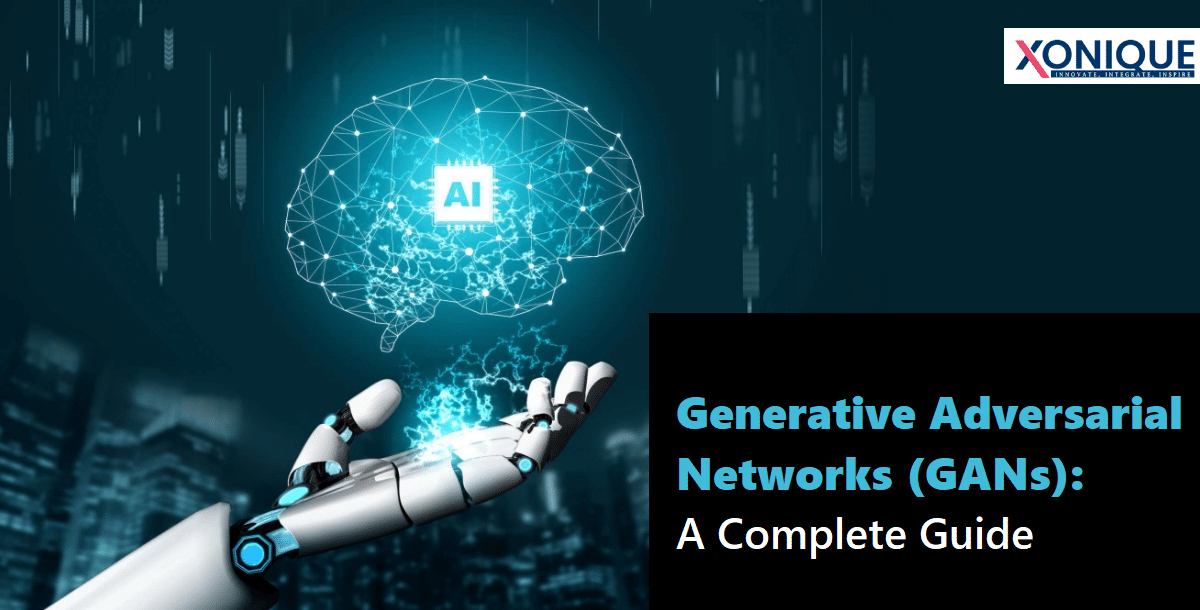In artificial intelligence, Generative Adversarial Networks (GANs) represent a transformative power, changing the face of computer imaging, vision, and much more. This comprehensive look into GANs will help you understand these complex networks and illuminate their origins, evolution, and the most cutting-edge methods.
The first time GANs were introduced was in 2014 by Ian Goodfellow and his colleagues. In 2014, GANs experienced incredible advancements, bringing them to the leading edge in AI research. The premise of GANs is in the dynamic interaction between the generator and the discriminator. This creates an adversarial learning process that creates artificial data that closely matches real-world examples.
When delving into the intricacies of GAN architecture, we will explore their numerous applications across different industries and consider the ethical concerns surrounding the development of GANs; this book is a complete guide for both experienced users and curious readers alike.
Join us to understand the transformative potential of GANs in shaping the future of artificial intelligence. Whether you’re an experienced user or a curious reader, this comprehensive guide covers everything. Additionally, we will explore the role of Generative AI Development Companies in driving innovation and implementation of GANs across various sectors.
Historical Evolution of Generative Adversarial Networks: From Inception to Today
The development of Generative Adversarial Networks (GANs) is a fascinating journey that covers a brief yet prolific time since their creation in 2014. Inception was through Ian Goodfellow and his collaborators. GANs were developed as a new method of generative modeling that forever changed the face of artificial intelligence.
The concept was simple but conceptually complex and involved pitting two networks of neural computation against one to play a game theory. The generator, responsible for creating artificial data, competes with the discriminator in charge of discerning between real and synthetic samples.
Initial implementations encountered challenges like mode collapse, in which the generator only produced a small amount of diversity within its outputs. Despite these challenges, however, the capabilities of GANs quickly became recognized, and researchers began to refine the structure and training methods. The introduction of methods like GANs from Wasserstein, progressive growth, and spectral normalization dealt with the issues of stabilization and convergence.
As time went on, GANs evolved beyond mere image generation. Their applications grew to encompass a variety of fields, including the transfer of style, text-to-image synthesizing, and the creation of completely new content types like prose and music. The development of conditional GANs permitted specific data synthesis, allowing access to specialized and specific applications.
GANs continue to be at the leading edge in AI research and are currently working to address ethical concerns, reduce biases, and look at new ways to build design concepts. Their journey from conceptualization to practical application illustrates the changing nature of this field as well as the constant search for advanced and effective machine-learning models.
Key Components of Generative Adversarial Networks: Generator and Discriminator
Generative Adversarial Networks (GANs) can function because of the interplay of two key components: The Generator and the Discriminator. These two components form the center of the adversarial framework that is the basis of GANs. GAN design is a groundbreaking concept developed in 2014 by Ian Goodfellow and his colleagues in 2014.
The generator is responsible for creating artificial data that resembles real-world scenarios. It starts with random noises as its input and then learns how to convert it into unrecognizable data from genuine samples. Through repeated adjustments, the generator aims to create more real-looking outputs. The training process is understanding the fundamental patterns and patterns that appear in the data used for training.
The other side of the equation lies in the discriminator that distinguishes between genuine data and synthetic samples generated from the generator. It is trained on both generated and real data, and the discriminator can determine probabilities for samples of input that classify them as genuine or generated. The Discriminator acts as an impartial judge, giving information to the Generator regarding the accuracy of the generated outputs.
The adversarial dynamics develop through a continuous feedback loop between the two parts. While the Generator strives to increase the quality of its outputs, the Discriminator is also improving its ability to differentiate between actual and generated data. This process of adversarial learning leads both components to a delicate equilibrium, as Generator outputs become increasingly complicated for the Discriminator to distinguish from actual data. In the realm of artificial intelligence, these adversarial interactions highlight the need for advanced Generative AI Development Services to navigate and harness the evolving landscape of generative models.
Understanding and optimizing the complex balance between the Generator and the Discriminator can be vital to unlocking the full power of GANs across various applications, such as image synthesis and text generation. The synergy between these two key components creates the amazing ability to generate GANs’ essence in modern artificial intelligence.
Understanding the Adversarial Training Framework
The Adversarial Training Framework forms the foundation of Generative Adversarial Networks (GANs), representing a paradigm shift in generative modeling in artificial intelligence. The idea was conceived by Ian Goodfellow and his collaborators in 2014; the framework is a game theory approach that pits two networks of neural networks against one another in a dynamic, antagonistic setting.
The heart of this framework is the interaction with the Generator and the Discriminator. The Generator creates synthetic data, starting with random noise as an input. Its goal is to generate outputs that can be compared to real data. On the other hand, Discriminator Discriminator is taught to distinguish between real and artificial data. As the Generator improves its outputs, the Discriminator also enhances its ability to differentiate between genuine and fake samples.
A feedback loop triggers the adversarial dynamics. The Generator strives to create increasingly realistic outputs to confuse the Discriminator, and the Discriminator improves its ability to discriminate and distinguish between generated and real data. The process continues to evolve until the equilibrium is reached. In this case, the Generator produces real-looking data, while the Discriminator cannot distinguish between synthetic and real samples.
Adversarial training allows GANs to record complex distributions of data and create content that reflects the complexity of data in real life. This unique framework has discovered applications in various domains, such as image synthesis and text generation. It continues to spur advancements in generative modeling. This marks an evolution in how artificial intelligence systems tackle the challenge of data generation.
Applications of GANs in Various Industries
Generative Adversarial Networks (GANs) have surpassed theoretical frameworks and are now indispensable instruments across many industries, showing their flexibility and transformative capabilities. GANs are used in a variety of applications. GANs are diverse and utilize their unique capability to create realistic and unique data.
In healthcare, GANs play a crucial role in medical imaging. They aid in enhancing images, segmentation, and even creating artificial medical images to help train deep-learning models. This assists in diagnosing diseases, treatment planning, and medical research. Leveraging the transformative power of GANs in healthcare requires advanced AI Development Services to ensure the seamless integration and optimization of these generative models for the benefit of medical imaging applications.
It is no secret that the media industry has harnessed GANs to serve diverse creative uses. From using deepfake technology in video and film production to creating realistic gaming environments, GANs are advancing the frontiers of immersive and visual storytelling experiences.
For finance, GANs can be used to detect fraud and assess risk. They can create synthetic financial data to test and validate models without risking sensitive data, thus enhancing the reliability of the financial system.
GANs also play a vital function within retail as they allow the creation of realistic designs and images. This helps with virtual experience-based try-ons, personalized advertisements, and forecasting trends in the market by synthesizing different consumer preferences.
For the manufacturing industry, GANs are used in creating and prototyping products by creating synthetic datasets to be used for training and testing for testing and training purposes. This speeds up the design lifecycle and improves the effectiveness of the design process.
The applications are further extended to defense and security in which GANs can be used to generate realistic simulations to train and create facial recognition technologies.
The diverse applications highlight the immense influence of GANs across different industries, which drive innovation, efficiency, productivity, and creativity in ways previously impossible to imagine. In the years ahead, as GAN technology continues to advance and expand its reach, its impact on different sectors is expected to grow, leading to the new age of data-driven products and experiences.
Challenges and Limitations in GAN Implementation
Despite the impressive popularity and success of Generative Adversarial Networks (GANs) However, their implementation is flexible. The solution to these challenges is essential to unlock all the potential in GANs across various applications.
A major issue is the problem in modes collapse in which the Generator can only produce a limited variety of its outputs, often converging to a small portion of the distribution it is trying to capture. This causes an absence of variation and creativity in the generated samples, which hinders the ability of the model to understand the entire depth of the data distribution.
Instability in training is another issue common when it comes to GAN implementation. The dynamic interactions between the Generator and the Discriminator could cause changes during the training process, making it difficult to reach a point of convergence. Methods such as alternative training and sophisticated optimization techniques have been developed to alleviate this problem.
GANs can also be sensitive to the selection of parameters and initialization conditions. Finding the ideal balance could be an extremely difficult job, and the wrong settings could cause poor convergence or failure in training.
Additionally, GANs are prone to attack from adversaries. Small changes to input data could result in substantial changes to the generated output, posing security threats for imaging recognition software.
The ability to interpret and the transparency of GANs is a challenge. Understanding the representations inside and the decision-making process of these complicated models can be difficult and makes it hard to trust their outputs for critical areas like finance or healthcare. Addressing this challenge necessitates the involvement of a specialized AI Development Company, dedicated to enhancing the interpretability and transparency of GANs, particularly in contexts where trust and reliability are paramount, such as in finance or healthcare applications.
In addition, GANs could show biases in the data used to train, which can lead to biased outputs. Reducing these biases is important, particularly in cases where equity and fairness are crucial.
Addressing these limitations and challenges is a constant field of study, and advances in GAN design, training methods, and ethical considerations are essential to making the most of GANs across various fields.
Recent Advances in GAN Architectures
The last few years have seen an explosion of innovations concerning Generative Adversarial Network (GAN) structures, advancing the generative design model to new levels. These advances aim to solve issues, improve stability, and enhance the capabilities of GANs for various purposes.
A significant advancement has been the introduction of progressive expanding techniques. NVIDIA researchers developed the idea. The progressive GANs start with low-resolution photos and gradually add more details, allowing for a more stable and stable training process and the creation of high-quality pictures with high resolution. This technique has proven to be successful in overcoming the challenges of unstable training and modes of collapse.
The creation of conditional GANs has added a new level of control over the process of generating. Limiting the model to specific attributes or labels like textual descriptions or class information, conditional GANs permit the creation of targeted and custom content. These have been used in image-to-image translation, style transfer, etc.
New designs such as Wasserstein GANs (WGANs) have gained popularity in the quest for stability and convergence. WGANs introduce the Wasserstein distance metric, which accurately and consistently measures the differences between real and generated data distributions. This improves training stability and an improved and reliable convergence process.
Another notable development is the investigation of mechanisms for attention in GANs. Inspired by their success in other deep-learning tasks, these mechanisms increase the ability of models to focus on the relevant features and relationships, resulting in enhancements in text and image generation tasks.
Additionally, researchers have delved into self-supervised learning methods for GANs, which allow models to acquire relevant representations of unlabeled data. This can lead to unsupervised domain adaption and enhanced generalization across different data sets.
These recent developments highlight the rapid growth of GAN research, pushing the limits of what’s possible in generative modeling. As GAN structures continue to improve, their impact on various sectors ranging from entertainment to healthcare will grow, bringing forth an era of real-time and varied data synthesizing.
Transfer Learning Using GANs: Leveraging Models that have been trained
Transfer learning using Generative Adversarial Networks (GANs) is a highly effective method that allows the use of already trained models to increase the efficiency and performance of new generative tasks. This method allows the transfer of knowledge from one field to another, thus reducing the need for extensive learning using limited data sets and facilitating the development of more robust and advanced models for generative design.
Leveraging Transfer Learning with GANs is a strategic approach that benefits from the expertise of specialized AI Development Solutions, enabling the seamless adaptation and optimization of generative models for diverse applications.
The method typically uses an already-trained GAN, usually a vast and varied dataset, to provide a base point for a new project. The model trained in advance captures the rich feature representations and learned patterns derived from the original domain. To meet the needs of the new job, the model can be refined or expanded to adjust its generative capabilities to the particulars of the domain to be targeted.
Transfer learning using GANs can be applied to various fields, such as image synthesizing, style transfer, or even tasks that cross-modalize. For example, a GAN trained on natural images can be tuned to create medical and real-looking medical images using limited labeled information.
A significant benefit of transfer learning using GANs is the potential to alleviate the difficulties associated with smaller datasets, training instabilities, and convergence issues. Utilizing the knowledge stored in a model that has been trained, practitioners can start the training process to prepare for new tasks while reducing computational resources and time.
As GAN research continues in the future, transfer learning will remain a key role in democratizing the use of generative models across a range of applications, encouraging creativity and efficiency in projects that require realistic and varied data generation.
Conditional GANs: Tailoring Generated Output to Specific Criteria
Conditional Generative Adversarial Networks (cGANs) advance generative modeling by giving a certain amount of control and specificity to the outputs generated. Contrary to traditional GANs, which create data with no explicit constraints, cGANs permit the inclusion of additional data, such as labeling of classes or particular attributes, into the process of generating.
The principle of cGANs is to impose conditions on the generator based on external data to allow the generation of data that meets specific criteria. In the case of image generation tasks, cGANs can be programmed to create images that belong to a specific type or class by supplying the appropriate labels as input for conditional input. This precise control over the generative process has broad impacts across different areas.
In image synthesizing, cGANs are employed for tasks like image–to–image translation and style transfer. By limiting the generator to particular attributes or pictures as reference, cGANs can transform input images by defined criteria, making it easier to perform tasks like turning the daytime scene into a night-time scene or applying artistic style to images.
Text-to-image Synthesis is another area in which we can excel. When described in a textual form as input conditional, a cGAN will generate images that correspond to the description. This ability is useful in fields like graphics design and content creation and aiding the visually impaired by turning text descriptions into images.
The potential of cGANs is broad across various areas, such as interior design, fashion, and industrial design, in which specialized and tailored results from generative models are beneficial. As research into conditional generative modeling advances, they are set to be a key component in creating custom, controllable, and contextually aware generative solutions for various applications.
The evolution of conditional generative modeling is propelled by the expertise and innovation of specialized Generative AI Development, ensuring the development of highly tailored and contextually relevant generative solutions in fields like interior design, fashion, and industrial design.
GANs for Image Generation: A Comprehensive Overview
Generative Adversarial Networks (GANs) have changed the face of image creation, providing an original method to create authentic and diverse visual content. They were first introduced in 2014 by Ian Goodfellow and his colleagues. In 2014, GANs employed a unique adversarial framework for training that consists of a generator and a discriminator, which results in images that closely resemble authentic examples.
In the image generation process requiring image generation, The Generator is responsible for changing random noise into data that is not distinguishable from actual images. The Discriminator will be taught to distinguish between real and synthetic samples. The interplay of these two components enhances the Generator’s capability to create more convincing images, and the Discriminator is trying to differentiate between genuine and fake data.
GANs have successfully created high-resolution, attractive images in different areas. Progressive GANs, for example, offer a systematic technique for creating photographs in stages, beginning with low resolution before gradually adding detail. This method improves the stability of training and leads to the production of high-quality, sharp images.
The uses of GANs in the generation of images are numerous, from face synthesis that is realistic to the transfer of style in the production of unique and creative artworks. GANs are also used in medical imaging to accomplish tasks such as denoising images and synthesizing realistic medical images to train deep-learning models.
As GAN research continues to advance in its capabilities, the capabilities of the generation of images continue to improve, expanding the boundaries of what’s possible in creating realistic and varied visual content. The constant advancements in GAN structures and training methods suggest a future in which GANs will become more integral in various industries that depend on high-quality and realistic image synthesizing.
Text-to Image Synthesis using GANs
Text-to-image synthesis with Generative Adversarial Networks (GANs) is a transformative software that connects natural language descriptions and visual content creation. It was developed as an extension to GAN technology; the technique permits the creation of real-looking images using textual descriptions, allowing an array of possibilities in areas such as graphics design and content production and the development of virtual worlds.
A Text-to-image GAN procedure typically conditions the generator based on textual input and includes the written description or list of keywords. The generator can then convert this textual information into visual information, resulting in images that match the description provided. On the other hand, its discriminator assesses the authenticity of the created images concerning the textual input. The advancement and optimization of Text-to-image GAN procedures often involve the expertise of specialized AI Development Agencies, ensuring effective conditioning, conversion, and assessment processes for generating visually accurate content from textual input.
This technology can be utilized across various fields like e-commerce, where images of products are generated from the descriptions of products written in text. Furthermore, it can be used in fields of creativity, such as graphic design, allowing artists to visualize ideas written in text. In gaming and virtual reality, GANs that use text to image aid in creating realistic, varied environments that react dynamically to texts.
Problems in this field include ensuring consistency between the textual input and the resulting image while maintaining creativity and diversity in the synthesis process. In the research process, we are trying to improve the models and make them more effective in recording the intricate details and nuances embedded in descriptions of text.
Text-to-synthesis made possible by GANs represents a significant step in integrating the natural processing of language and computer vision, providing a powerful method to translate textual concepts into vibrant visual representations. As technology continues to advance, this technology will play a major part in various industries, expanding the possibilities of creative content creation.
GANs in Healthcare: Revolutionizing Medical Imaging
Generative Adversarial Networks (GANs) are emerging as a transformative technology in healthcare, especially in imaging for medical purposes, contributing to advances in diagnosis and treatment planning research. GANs provide a revolutionary method of synthesizing authentic medical images, solving the problems caused by limited data, and improving the abilities of medical imaging equipment.
One of the most important applications for GANs in healthcare is the creation of synthetic medical images for deep-learning models to train. More labeled medical data poses a challenge to developing accurate and robust models. GANs can help overcome this issue by creating diverse and authentic artificial images that can be used to enhance the training process, resulting in better model performance.
When denoising images for medical purposes, GANs play an essential function by creating clean images from noisy inputs. This is especially useful for improving the quality of images taken from medical facilities by various imaging methods, including Magnetic Resonance Imaging (MRI) and computed tomography (CT) images, and enhancing the precision of diagnosis procedures.
Furthermore, GANs aid in enhancing medical datasets, allowing for the development of anatomical variations and conditions. This assists in developing models that can be generalized to various patient populations and clinical situations.
GANs can also be used in style transfer to medical images, which allows the adaptation of the image’s characteristics to suit the specific clinical setting or device. This helps ensure the consistency and compatibility of the interpretation of medical images across various health institutions.
In the course of GAN, research in the field of healthcare progresses, and impacts on diagnosis, treatment planning, and medical studies are becoming more important and are bringing about an era of innovation based on artificial intelligence and imaging for healthcare.
Ethical Considerations in GAN Development and Deployment
Developing and deploying Generative Adversarial Networks (GANs) have ethical implications that require careful consideration. Since these powerful models are used in various fields, ranging from health care to creative industries, ensuring fair and responsible usage is essential.
A major ethical issue is the possibility of using GANs to produce fake content, in which realistic images or videos are created to deceive or manipulate. Deepfakes could be used for malicious reasons, for example, spreading false information and identity theft, as well as creating fake content. Mitigating the risks of deepfakes is not just about technological protections but also solid ethical guidelines and laws.
The responsible advancement and deployment of GANs involve careful consideration of ethical implications, requiring collaboration between technology experts and policymakers to establish robust AI Development practices, ethical guidelines, and legal frameworks to address and prevent the misuse of generative technologies.
GANs can accidentally perpetuate biases that are present based on training. When the data used for training has inaccurate representations, the outputs could reflect and amplify the biases present, leading to ethical issues related to equitable fairness. Ensuring diversity and fairness in training datasets and using measures to identify and reduce biases is crucial to solving this ethical dilemma.
Privacy concerns also arise in GAN applications, especially when the models create realistic representations of people. Finding a balance between the development technology of GAN technology and protecting individuals’ privacy is crucial, which requires the development of specific guidelines and rules.
Additionally, GANs in healthcare, although promising in medical imaging, need careful consideration of patient privacy concerns and consent. The creation of artificial medical images poses questions regarding ownership of the data, consent for data use, and the potential consequences of using data generated for clinical decision-making.
As GAN technology develops, an ethical framework must guide its development and implementation. This requires transparent and responsible methods, strong regulations, and continuous dialogues with stakeholders to navigate the complicated moral terrain surrounding GANs.
Mitigating Bias and Fairness Concerns in GANs
Reducing bias and assuring fairness to ensure fairness in Generative Adversarial Networks (GANs) is essential to encourage ethical and equitable use of these powerful models of generative design. GANs, like other machine learning models, can be susceptible to inherited or even amplified biases in the data used to train. You need a multifaceted approach that spans data collection, model structure, and evaluation methods to address these issues.
One of the most effective strategies to reduce bias is ensuring that there are diverse and accurate training data. By taking data from a broad range of sources, researchers can minimize the chance of model learning and perpetuating biases specific to the data in a single dataset. Additionally, using data augmentation and preprocessing techniques that combat biases could result in more equitable and fair model outputs.
Collaborating with a specialized Generative AI Company becomes crucial in implementing and advancing strategies to reduce bias, ensuring that the training data is diverse and accurately reflects the real-world context, ultimately contributing to the development of more equitable and unbiased AI models.
Researchers are also looking at ways to alter GAN structures to consider specific aspects of fairness. For instance, including adversarial components in training that concentrate on minimizing the impact of disparate factors on various demographic groups could assist in reducing bias in outcomes. Furthermore, methods such as regularization based on fairness can be utilized during training to ensure fairness in the created content.
Continuous research into the area of algorithmic fairness as well as interpretability is vital in the development of standardized measures and evaluation frameworks that can determine the fairness of GAN-generated outputs. Establishing clear guidelines for the ethical usage of GANs and the clear disclosure of weaknesses and shortcomings is crucial for ensuring responsible use.
Collaboration among teams from different disciplines, including experts from ethics, machine learning, and applications specific to the domain, is crucial to developing complete strategies to reduce bias and improve fairness within GANs. With these strategies, developers can move towards making more accountable and objective-generated models beneficial to various applications.
Future Directions and Emerging Trends in GAN Research
Prospects for Generative Adversarial Networks (GANs) offer a variety of exciting new directions and trends as researchers continue pushing the boundaries of Generative modeling. Certain key areas are predicted to determine the direction of GAN research over the next years.
Robustness and Stability
The stability and robustness of GAN training is a major issue. Researchers are constantly looking for ways to tackle issues like mode collapse, instability in training, and increasing convergence rates to create more stable and effective GAN structures.
Conditional and Controllable Generation
The future of GANs will likely feature more controls and capabilities for conditioning. The advancements in conditional GANs and techniques for fine-tuning the created content according to specific characteristics or styles will lead to more customized and customizable outputs.
Embracing these advancements requires expertise in leveraging the latest developments, and specialized Generative AI Services will play a crucial role in implementing, fine-tuning, and customizing GANs for a wide range of applications, paving the way for highly tailored and versatile generative solutions.
Ethical AI and Bias Mitigation
The ethical issues regarding GANs will remain a primary research topic. The efforts to reduce biases, improve fairness, and establish clear ethics guidelines for GAN creation and deployment will likely evolve to ensure the integrity and impartiality of GANs that generate models.
Cross-Modal and Multimodal GANs
Integration of GANs across different modes, including text and image creation, is expected to increase. Multimodal GANs that can synthesize information across different domains, like creating images from text descriptions, will be more prevalent.
Federated Learning and Privacy
GAN research will likely connect with federated learning strategies, allowing the models to learn on uncentralized data sets while also addressing privacy issues. Ensuring GANs respect privacy and security is crucial to their widespread acceptance.
Real-World Applications
GANs will be increasingly important in real-world applications, including personalized content creation to assist in scientific research and healthcare diagnosis. As GANs develop and become more practical, their use in solutions for various industries will continue to grow.
The future of GAN research is very promising, with constant innovations that will drive advances in generative modeling. It will also contribute to various applications that affect different aspects of our physical and digital worlds.
The Key Takeaway
Ultimately, a journey through the world of Generative Adversarial Networks (GANs) is a fascinating mix of innovation and challenges. From their initial introduction as a revolutionary concept in 2014, to the present sophisticated designs, GANs have generatively changed the world of modeling.
The study of the evolution of history, as well as the key components and numerous applications, highlights their transformative impact on all industries. However, ethical concerns, biases, and issues in their implementation highlight the need for ethical development and deployment.
To address these considerations, it is advisable to hire Generative AI developer who can contribute to the responsible development and deployment of these technologies, ensuring a balance between innovation and ethical considerations.
As GAN research continues to advance, new avenues of potential use, like the use of conditional generation and fairness improvements and applications in real-world settings, signal the future in which GANs are playing a more significant influence on how we create and work with data. The constant pursuit of fairness, stability, and ethical frameworks will ensure that GANs continue to evolve into powerful instruments, encouraging creativity and innovation and accountable AI techniques in the future.











